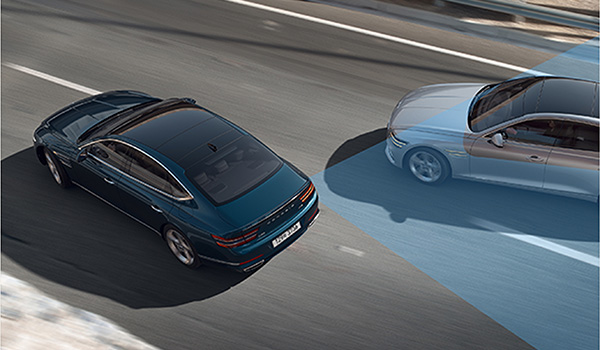The use of cameras and sensors for Advanced Driver Assistance Systems (ADAS) have facilitated a wide range of new technologies that mean cars have never been safer, but also never more confusing, thanks to the adoption of new terminologies and acronyms to describe them.
With that in mind, here’s a brief guide to some of the more significant new safety technologies, their acronyms and what they do.
Individual brands may have their own descriptive terms for what is essentially the same underlying technology, so for the sake of consistency, we’ve used Hyundai-Genesis terminology throughout.
Forward Collision-Avoidance Assist (FCA)
This provides a warning if the vehicle ahead suddenly slows down or if a forward collision risk is detected, such as a stopped vehicle, pedestrian, or cyclist in front. If the risk of collision increases, the system can automatically brake and take evasive steering action. FCA can be further enabled to detect and assist if there is a risk of collision with a cyclist or an oncoming vehicle while turning right at an intersection (junction turning). Other functionality includes ‘junction crossing’ which detects if there is a risk of collision with oncoming vehicles from the left or right while driving through an intersection, with the system able to brake and/or steer to avoid a collision. In addition, when changing lanes, if there is a risk of collision with a vehicle in an oncoming lane, or a vehicle travelling in the same direction in an adjacent lane, the system can automatically steer to avoid a collision. The automatic steering function also works if there is a risk of collision with a pedestrian.
Blind-Spot Collision-Avoidance Assist (BCA)
Provides a warning when operating the turn signals to change lanes in the event there is a risk of collision with a vehicle approaching from the rear on the corresponding side. If the risk of collision increases after the warning, the system can automatically control the vehicle to help avoid a collision. If, when exiting a parallel parking space, the system detects a risk of a collision with a vehicle approaching from the rear, it can automatically assist with emergency braking.
Safe Exit Assist (SEA)
It helps prevent occupants from exiting the vehicle when it’s unsafe to do so, such as when a vehicle approaches from the rear. SEA works in conjunction with the electronic child lock interlock to keep the doors locked while warning that approaching vehicles may make it unsafe to exit the vehicle.
Intelligent Speed Limit Assist (ISLA)
Monitors road signs using a front camera and navigation data to warn drivers if their vehicle exceeds the relevant posted speed limit.

Driver Attention Warning (DAW)
Uses a windscreen-mounted camera to monitor the vehicle’s position within the lane, while also tracking steering inputs, brake pedal inputs and elapsed driving time. If the system detects careless driving, such as sudden steering or braking inputs, and/or the inability to keep within a lane, it will recommend the driver takes a break.
Leading Vehicle Departure Alert (LVDA)
Monitors the vehicle ahead when stopped in traffic. If the vehicle in front drives off and the LVDA-equipped vehicle fails to accelerate away, the system sounds a chime to alert the driver.
Blind-Spot View Monitor (BVM)
Displays video of the blind-spot area to give the driver a clear view of the surroundings and allow for safe lane changes. When operating the turn signals, the system displays video of the blind-spot view for the corresponding side.
High Beam Assist (HBA)
Automatically adjusts headlight range to avoid dazzling the occupants of vehicles ahead. The system uses a windscreen-mounted camera to scan the road ahead, monitoring for streetlights and other lights, including the headlights and taillights of vehicles ahead and switches from high to low beam accordingly.
Intelligent Front-Lighting System (IFS)
Allows the continuous use of high-beam headlights without dazzling the occupants of vehicles ahead. By using headlights comprising multiple LEDs with individual electronic control, sections of the headlight can be selectively dimmed (or turned up) as required.
Smart Cruise Control (SCC with machine learning)
Applies logic that learns the driver's tendencies and is then able to operate the vehicle in a similar manner when SCC is active. The function learns the driver's driving style (inter-vehicle distance, acceleration, reaction speed) when SCC is inactive, to drive automatically in a style that reflects that of the driver when activated.
Lane Following Assist (LFA)
Uses the front-mounted camera to monitor vehicles ahead and establish the centre line of the lane, providing steering assistance to help keep the vehicle centred in the lane.
Rear-View Monitor (RVM)
Displays a rear camera view while parking and during driving. During parking, the rear camera display features guide lines that show the path of the vehicle based on the applied steering lock. A rear top view also assists for parking manoeuvres as well as trailer hooking.
Surround View Monitor (SVM)
Displays a high-quality, accurate view of vehicle surroundings while driving and parking, as well as offering 3D viewing capabilities.
Provides a warning to help prevent collisions with pedestrians or objects during parking or when leaving a parking space.
Parking Collision-Avoidance Assist (PCA) – Reverse
Warns the driver if it detects a potential collision risk when reversing and will automatically brake if the risk of collision increases.
Rear Cross-Traffic Collision-Avoidance Assist (RCCA)
Provides a warning if there is a risk of collision with an oncoming vehicle on the left or right side while reversing and will automatically brake if the risk of collision increases.
Smart Parking Assist (SPA)
Provides automated steering, accelerator and drive selection to reduce driver effort when manoeuvring into and out of tight parking spaces.
Remote Smart Parking Assist (RSPA)
Allows users to park a vehicle remotely from outside the vehicle, allowing occupants to exit the vehicle easily, before it is parked in a tight space. Uses a wide-angle camera and an ultrasonic sensor to search for a parking space, then recognises the parking lines as well as surrounding objects to let the driver remotely park. System can automatically steer, accelerate, decelerate and select drive.
Rear Occupant Alert (ROA)
Prevents children or pets from inadvertently being left in the vehicle by alerting the driver to check for them before exiting the vehicle. System can register that a rear door was opened and will alert the driver to check the rear seats when they turn off the vehicle.
Multi-Collision Brake (MCB)
Operates to prevent or lessen the severity of a secondary collision. The system is activated after the airbags have deployed and if brake or accelerator pedal input is not detected, it automatically applies the brakes.





